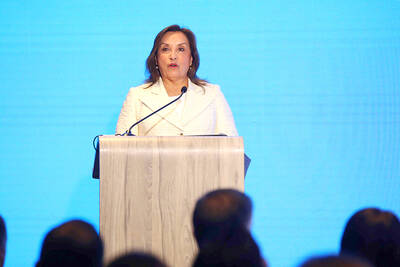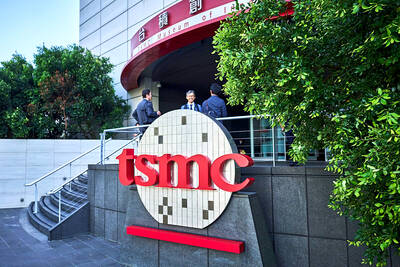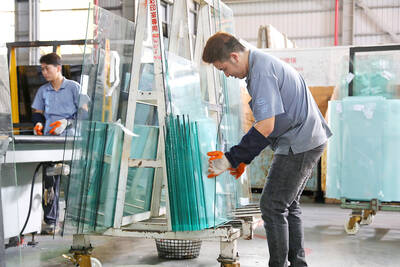As Nike Inc attempts to cut hazardous wastewater discharge in the dyeing process of its supply chain, it is both a challenge and an opportunity for Far Eastern New Century Corp (遠東新世紀).
It is a challenge because investing in new dyeing equipment is very expensive; yet it generates technological advancement, as well as new business opportunities.
Last week, the Taiwanese manufacturer of textile products said that it plans to double its capacity for waterless dyeing to 120 tonnes a month by the end of next year.
Far Eastern New Century has two waterless dyeing machines, which it purchased from Netherlands-based DyeCoo Textil Systems BV. They have a total capacity of 60 tonnes a month and are at its plant in Taoyuan County’s Guanyin Township (觀音).
Far Eastern New Century is scheduled to purchase another two machines by the end of next year, vice president He Kun-lin (何昆麟) said on the sidelines of the Taipei Innovative Textile Application Show (TITAS), a three-day exhibition that ran from Oct. 15 to Oct. 17 in Taipei.
He said a waterless dyeing machine costs about NT$100 million (US$3.29 million), which is about 10 times more than the price of a traditional dyeing machine.
Water-free dyeing currently accounts for 1 to 2 percent of the company’s dyeing capacity and the new technology is now 90 percent as efficient as the traditional dyeing approach.
The company is also seeking to sell fabrics using the new dyeing technology to Japan-based Fast Retailing Co, which operates Uniqlo, and plans to talk with Adidas AG in the near future, according to He.
Among the 10 national teams in the 2014 FIFA World Cup sponsored by Nike, two teams wore soccer kits manufactured by Far Eastern New Century’s water-free dyeing technology, He said, adding that Nike plans to use the new technology to make soccer kits for some of the teams it sponsors in 2016 UEFA Champions League, and all of the teams it sponsors in the 2018 FIFA World Cup.
However, the water-free dyeing technology can only be used to dye polyester, and Far Eastern New Century and DyeCoo are still working on applying the technology to dyeing nylon and cotton, He said.
Far Eastern New Century’s waterless dyeing facility, which was launched on Dec. 3 last year, is the first in the nation and the first in Nike’s supply chain.
The new dyeing technology is named “ColorDry” by Nike.
“ColorDry technology removes water from the dyeing process by using recycled [carbon dioxide] to infuse fabric with intense, saturated color,” Nike said in a press release on June 13, when it launched its first product using waterless dyeing technology.
According to Nike, the traditional dyeing process needs to use 100 to 150 liters of water to dye 1kg of textile.
As the waterless dyeing process is carried out under high pressure to turn carbon dioxide into liquid form, only companies in Taiwan and Thailand have met the safety requirements for running such facilities thus far, according to Taiwan Textile Research Institute (TTRI, 紡研所).
The waterless dyeing facility in Thailand is owned by textile maker Yeh Group’s subsidiary Tong Siang Co, which manufactured fabrics for Adidas AG’s waterless dyeing products launched in 2012, the Taipei-based institute said.
In Taiwan, in addition to Far Eastern New Century, textile makers Formosa Taffeta Co (福懋興業) and Eclat Textile Co (儒鴻) have also installed waterless dyeing facilities, the institute said.
Formosa Taffeta has three machines it purchased from DyeCoo in July and can produce 365,760m of polyester a month, a company official, who declined to be named, said by telephone on Tuesday.
The official said the company’s factory has space to expand its capacity to between 3,657,600m and 4,572,000m of fabrics a month, but it does not have a timetable for the expansion so far.
Eclat has three machines purchased from DyeCoo, with each of them able to process 600kg of fabrics at a time, an industry watcher told the Taipei Times by telephone on Friday.
However, it is still too early for the new technology to generate significant profit for the three Taiwanese companies because the demand for waterless dyeing fabrics is still low, the official said.
“A traditional dyeing facility needs to make 10 tonnes of fabric a month to break even,” he said.
After a report issued by Greenpeace in July 2011 criticized international apparel brands, including Nike, Adidas and Puma SE, for cooperating with two Chinese textile facilities found to be discharging harmful chemicals into water, a group of apparel brands made a commitment to help cut hazardous water discharge in the industry to zero by 2020, according to Zero Discharge of Hazardous Chemicals Group, a platform set up by these brands.

With an approval rating of just two percent, Peruvian President Dina Boluarte might be the world’s most unpopular leader, according to pollsters. Protests greeted her rise to power 29 months ago, and have marked her entire term — joined by assorted scandals, investigations, controversies and a surge in gang violence. The 63-year-old is the target of a dozen probes, including for her alleged failure to declare gifts of luxury jewels and watches, a scandal inevitably dubbed “Rolexgate.” She is also under the microscope for a two-week undeclared absence for nose surgery — which she insists was medical, not cosmetic — and is

GROWING CONCERN: Some senior Trump administration officials opposed the UAE expansion over fears that another TSMC project could jeopardize its US investment Taiwan Semiconductor Manufacturing Co (TSMC, 台積電) is evaluating building an advanced production facility in the United Arab Emirates (UAE) and has discussed the possibility with officials in US President Donald Trump’s administration, people familiar with the matter said, in a potentially major bet on the Middle East that would only come to fruition with Washington’s approval. The company has had multiple meetings in the past few months with US Special Envoy to the Middle East Steve Witkoff and officials from MGX, an influential investment vehicle overseen by the UAE president’s brother, the people said. The conversations are a continuation of talks that

CAUTIOUS RECOVERY: While the manufacturing sector returned to growth amid the US-China trade truce, firms remain wary as uncertainty clouds the outlook, the CIER said The local manufacturing sector returned to expansion last month, as the official purchasing managers’ index (PMI) rose 2.1 points to 51.0, driven by a temporary easing in US-China trade tensions, the Chung-Hua Institution for Economic Research (CIER, 中華經濟研究院) said yesterday. The PMI gauges the health of the manufacturing industry, with readings above 50 indicating expansion and those below 50 signaling contraction. “Firms are not as pessimistic as they were in April, but they remain far from optimistic,” CIER president Lien Hsien-ming (連賢明) said at a news conference. The full impact of US tariff decisions is unlikely to become clear until later this month

Nintendo Co hopes to match the runaway success of the Switch when its leveled-up new console hits shelves on Thursday, with strong early sales expected despite the gadget’s high price. Featuring a bigger screen and more processing power, the Switch 2 is an upgrade to its predecessor, which has sold 152 million units since launching in 2017 — making it the third-best-selling video game console of all time. However, despite buzz among fans and robust demand for pre-orders, headwinds for Nintendo include uncertainty over US trade tariffs and whether enough people are willing to shell out. The Switch 2 “is priced relatively high”